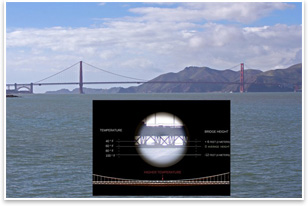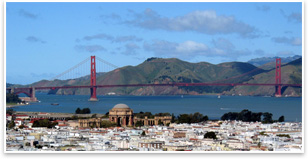
| San
Francisco’s
Outdoor Exploratorium Links Nature and Perception How do you . . . engage people in their environments? Summary: A new Outdoor Exploratorium in San Francisco, the city of the 2009 AIA National Convention, features a collection of 20 new outdoor interactive artful science exhibits and artworks that key into how people see and interpret their environment. The hundreds of interactive exhibits at the Exploratorium are usually housed within the walls of San Francisco's landmark Palace of Fine Arts, in the areas of science, art, and human perception. For this line of inquiry, the museum departed from its landmark building to lead people on their own discoveries outside its campus.
Architecture as instrumentation Closer to the street, the “Wind Arrows” exhibit shows how at ground level, wind often seems to flow in fairly unified streams without much variation in direction at different heights. But, in actuality, wind is highly stratified, with vertical layers often blowing at right angles to one another across short vertical distances.
Sense of Place
Visitors can find the Outdoor Exploratorium at Fort Mason between San Francisco's Aquatic Park and the Marina District, beginning in mid-March 2009. Dotted along the waterfront at Fort Mason Center and in the adjoining 55-acre National Park of Upper Ft. Mason, these exhibits harness the wind, the waves, marine life, and the man-made and natural environments. |
||
Copyright 2009 The American Institute of Architects. All rights reserved. Home Page |
||
news headlines
practice
business
design
recent related
› When Times Are Tough, Networking Is Key
› AIA Convention Now Includes Navigating the Economy Track
Find out more about the AIA 2009 National Convention and Design Exposition in San Francisco, April 30–May 2. The AIA Convention Committee has just added a comprehensive set of programs on Navigating the Economy. To learn more, visit the convention Web site.
Photos:
Images courtesy of the Exploratorium.
1: Wind arrows turn the urban landscape into a large-scale wind observatory.
2: The Outdoor Exploratorium utilizes San Francisco’s Golden Gate Bridge as a instrument to measure changing temperature patterns.

 This installation, the Exploratorium’s first extended foray into the outdoors, is a long-term experiment as the hands-on science museum considers the nexus of the environment and the San Francisco waterfront. The experiments also serve as subtle outdoor exhibitry that capitalizes on the north-facing shoreline and its expansive views of San Francisco Bay, Alcatraz, and the Golden Gate Bridge, among other landmark sites. There is no charge.
This installation, the Exploratorium’s first extended foray into the outdoors, is a long-term experiment as the hands-on science museum considers the nexus of the environment and the San Francisco waterfront. The experiments also serve as subtle outdoor exhibitry that capitalizes on the north-facing shoreline and its expansive views of San Francisco Bay, Alcatraz, and the Golden Gate Bridge, among other landmark sites. There is no charge. Using sailboat wind indicators arranged at regular intervals on
a vertical pole, Wind Arrows reveals the complex wind stratification
patterns of the San Francisco Bay shoreline. Interpretive graphics
encourage visitors to transfer their observations from Wind Arrows
to the adjacent urban skyline. By comparing the directions of waving
flags at different heights and locations along Hyde Street Pier,
Fisherman’s Wharf, and Aquatic Park, the surrounding urban architecture reveals itself as a large-scale wind observatory.
Using sailboat wind indicators arranged at regular intervals on
a vertical pole, Wind Arrows reveals the complex wind stratification
patterns of the San Francisco Bay shoreline. Interpretive graphics
encourage visitors to transfer their observations from Wind Arrows
to the adjacent urban skyline. By comparing the directions of waving
flags at different heights and locations along Hyde Street Pier,
Fisherman’s Wharf, and Aquatic Park, the surrounding urban architecture reveals itself as a large-scale wind observatory. The Outdoor Exploratorium goes deeper, staff note, to reveal more
subtle phenomena surrounding us. Visitors are encouraged to examine
pier pilings oscillating in response to incoming waves, interpret
signs of geological change, and investigate the unique growth of
plants adapted to colonizing the fractures in an asphalt parking
lot. The Outdoor Exploratorium at Fort Mason is a place designed
to involve the public in both overt and hidden wonders.
The Outdoor Exploratorium goes deeper, staff note, to reveal more
subtle phenomena surrounding us. Visitors are encouraged to examine
pier pilings oscillating in response to incoming waves, interpret
signs of geological change, and investigate the unique growth of
plants adapted to colonizing the fractures in an asphalt parking
lot. The Outdoor Exploratorium at Fort Mason is a place designed
to involve the public in both overt and hidden wonders.